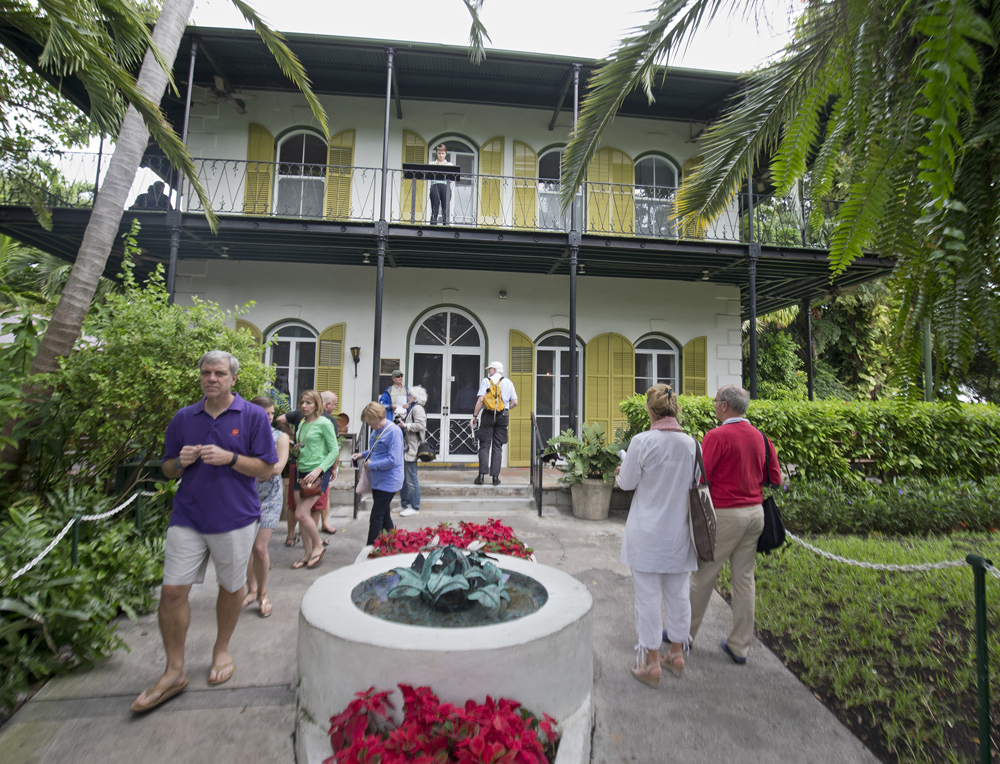“I learned never to empty the well of my writing,” said Ernest Hemingway, “but always to stop when there was still something there in the deep part of the well, and let it refill at night from the springs that fed it.”
Hemingway, whose springs ran deep, spent nearly a decade living and working in Key West. As the first widely-renowned author to make it his home, he inspired generations of writers and readers to follow in his footsteps and explore the island’s innate creativity.

Key West’s famed Sloppy Joe’s Bar has welcomed patrons — including literary legend Ernest Hemingway — at Duval and Greene streets for 80 years. (Photo by Rob O’Neal)
From July 18-23, his legacy will be celebrated during Key West’s annual Hemingway Days celebration. Events include a look-alike contest for Hemingway hopefuls, prose and poetry readings, the wacky “Running of the Bulls,” presentations on Ernest and his influence, and a three-day marlin tournament recalling his fascination with fishing.
Encouraged by his friend John Dos Passos, Ernest Hemingway first visited Key West in April of 1928. By 1931, he and his wife Pauline were ensconced in a Spanish Colonial villa on Whitehead Street — a property Hemingway would own until his death.
During his time on the island, Hemingway wrote many of this best-known works including “Death in the Afternoon,” “For Whom the Bell Tolls,” “The Green Hills of Africa,” “The Snows of Kilimanjaro” and “The Short Happy Life of Francis Macomber.” He chose Depression-era Key West as the setting for his brilliant “To Have and Have Not” — his only novel with an American locale.
In addition to writing, Hemingway devoted himself to enjoying life on the island. He refereed boxing matches in the Bahama Village district, and sparred with young fighters including the late Kermit “Shine” Forbes. He became a passionate deep-sea fisherman, frequenting the waters between Key West and Cuba in his boat, the “Pilar” — once tallying 54 marlin in 115 days.
And he spent long, lazy hours at Sloppy Joe’s Bar, owned by his friend and fishing companion Joe Russell, drinking with a “mob” of literary notables and local compadres. Hemingway and Russell became friends when Russell cashed a royalty check that the local bank wouldn’t accept — and the author referred to himself as a silent partner in Russell’s saloon.

2014 Hemingway Look-Alike Contest winner Wally Collins poses in front of the Ernest Hemingway Home & Museum (with a feline friend likely descended from Ernest’s own cat). (Photo by Andy Newman, Florida Keys News Bureau)
After Hemingway found inspiration in Key West, novelists and poets and essayists and writers of all sorts followed. The early literary visitors included Hart Crane, Archibald MacLeish and Wallace Stevens.
Robert Frost made frequent winter visits, staying at the Caroline Street property of Jessie Porter Newton; Tennessee Williams owned a home in Key West from the late 1940’s until he died.
The island’s more recent writer-residents have included Ann Beattie, Judy Blume, Jimmy Buffett, Phil Caputo, Meg Cabot, David Kaufelt, Alison Lurie, Thomas McGuane, Shel Silverstein and Mark Childress.
Yet, perhaps because he sparked the influx of literati that has become so important to Key West’s identity, Ernest Hemingway’s legend has never been overshadowed by that of another writer.
His is the home that, as a museum and shrine, is visited by tens of thousands of people each year. His is the image that stares from Sloppy Joe’s t-shirts and coasters and cooler cups and myriad other merchandise, commemorating his fondness for the bar.
And his is the spirit that, each year during Hemingway Days, still draws writers and readers, look-alikes and anglers to the island he loved — hoping that they too can drink at the springs that fed his creative well.

